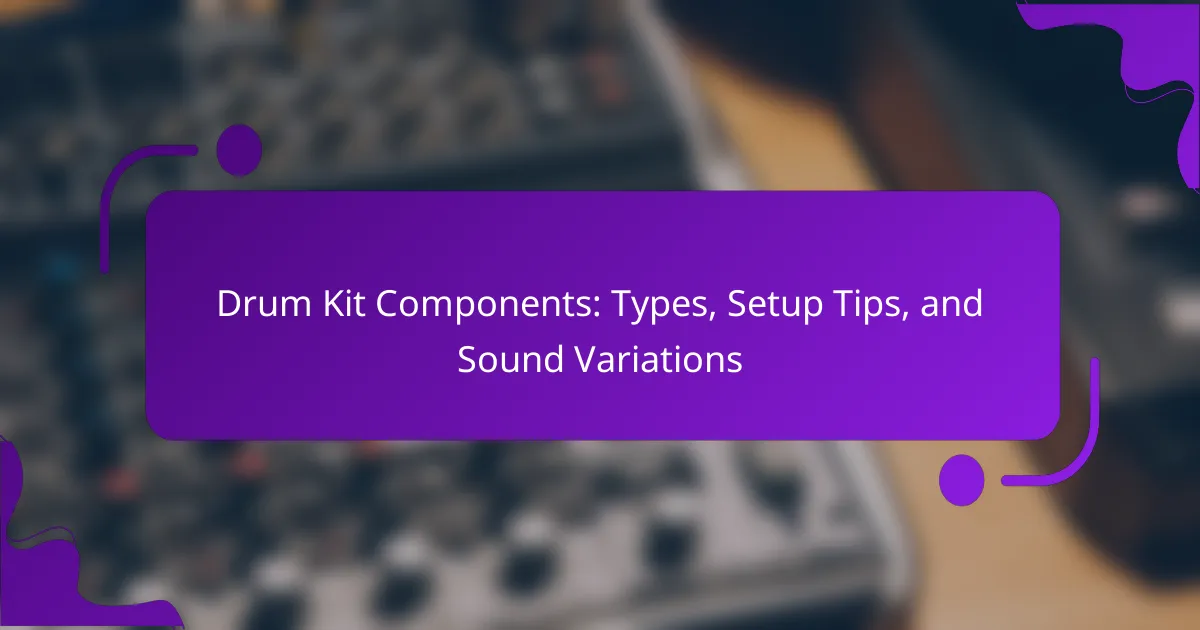A drum kit is a musical instrument consisting of several primary components: the bass drum, snare drum, toms, cymbals, and hardware. Each part plays a crucial role in producing sound; the bass drum delivers deep tones, the snare drum offers sharp sounds, and the toms add melodic elements. Proper setup involves strategically positioning these components for optimal accessibility and sound quality. Additionally, sound variations can be achieved through tuning, different playing techniques, and the use of various drumsticks and electronic kits, enhancing the versatility of the drum kit. This article provides a detailed overview of drum kit components, setup tips, and the diverse sound possibilities they offer.

What are the main components of a drum kit?
A drum kit consists of several main components. These include the bass drum, snare drum, toms, cymbals, and hardware. The bass drum provides the deep, resonant sound and is typically played with a foot pedal. The snare drum produces a sharp, crisp sound and is commonly used for backbeats. Toms add melodic tones and come in various sizes, including rack and floor toms. Cymbals, such as hi-hats, crash, and ride, add texture and accent to the music. Hardware includes stands, pedals, and supports that hold the drums and cymbals in place. Each component contributes to the overall sound and functionality of the drum kit.
How do different drum kit components contribute to overall sound?
Different drum kit components significantly influence the overall sound. The bass drum provides a deep, resonant thump that forms the foundation of the rhythm. The snare drum adds a sharp, crisp attack that cuts through the mix. Tom-toms contribute a range of tones, from warm and full to high-pitched and bright, depending on their size and tuning. Cymbals, including hi-hats and crash cymbals, introduce brightness and sustain, adding texture to the overall sound. Each component’s material, size, and tuning affect the tonal characteristics, creating a unique sound profile. For instance, a thicker shell produces a warmer sound, while a thinner shell offers more resonance. This interplay of components defines the drum kit’s overall sonic identity.
What role does the bass drum play in a drum kit?
The bass drum is a fundamental component of a drum kit. It provides the primary rhythmic foundation in music. This drum produces low-frequency sounds that drive the beat. Typically, it is played with a foot pedal, allowing drummers to keep time effortlessly. The bass drum supports the overall dynamics of a song. It can vary in size, usually ranging from 18 to 26 inches in diameter. Larger bass drums produce deeper, resonant tones. In various music genres, the bass drum’s role can shift, from a steady pulse in rock to syncopated patterns in jazz.
How do snare drums differ in sound and construction?
Snare drums differ in sound and construction primarily due to their materials and design features. The shell material, such as wood or metal, significantly influences the tonal quality. For example, wood shells produce warmer tones, while metal shells yield brighter, more cutting sounds. The diameter and depth of the drum also affect the pitch; shallower drums tend to have higher pitches, while deeper drums produce lower frequencies.
The type of snare wires used impacts the snare’s response and sensitivity. Different wire materials and configurations can create distinct snare sounds. Additionally, the drumhead type, whether coated or clear, alters the attack and sustain of the sound.
Construction techniques, such as the number of plies in the shell or the bearing edge shape, further differentiate snare drums. For instance, single-ply shells may resonate more freely, while thicker, multi-ply shells offer durability and a focused sound. These variations lead to a wide range of tonal possibilities, catering to different musical styles and preferences.
What types of toms are commonly used in drum kits?
The types of toms commonly used in drum kits are rack toms and floor toms. Rack toms are typically mounted above the bass drum. They are smaller in size and provide a higher pitch. Floor toms are larger and sit on the ground. They produce a deeper, resonant sound. Both types are essential for creating a full drum sound. The standard configuration includes one or two rack toms and one floor tom. This setup allows for versatile playing styles. Many drummers choose different sizes for tonal variety.
How do cymbals enhance the sound of a drum kit?
Cymbals enhance the sound of a drum kit by adding brightness and complexity to the overall tone. They produce a wide range of frequencies that complement the bass and snare drums. This creates a fuller sound profile in musical arrangements. Different types of cymbals, such as hi-hats, crash, and ride, serve specific roles. Hi-hats provide a sharp, cutting sound that can articulate rhythms. Crash cymbals add explosive accents, while ride cymbals offer a sustained, melodic tone. The interaction between cymbals and drums creates dynamic contrasts in music. This dynamic range allows drummers to express various musical styles effectively.
What are the various types of drum kits available?
There are several types of drum kits available. The most common types include acoustic drum kits, electronic drum kits, hybrid drum kits, and compact drum kits. Acoustic drum kits consist of wooden shells and are played with drumsticks. They produce a natural sound and are favored in live performances. Electronic drum kits use sensors and triggers to produce sounds through a module. They offer versatility and are ideal for practice and recording. Hybrid drum kits combine elements of both acoustic and electronic kits, allowing for a broader range of sounds. Compact drum kits are smaller and designed for portability, making them suitable for small spaces or travel. Each type serves distinct purposes and preferences for drummers.
How do acoustic and electronic drum kits compare?
Acoustic drum kits produce sound through physical vibration of drumheads. Electronic drum kits generate sound via digital samples and triggers. Acoustic kits typically offer a richer, more organic sound. They respond naturally to playing dynamics. Electronic kits provide versatility with various sound options and effects. They often include built-in metronomes and practice features. Acoustic kits require more space and are generally louder. Electronic kits can be played silently with headphones. Both types cater to different playing styles and environments.
What are the benefits of using a hybrid drum kit?
Hybrid drum kits combine acoustic and electronic elements. This setup offers versatility in sound production. Musicians can achieve a wide range of tones and effects. Hybrid kits allow for easy integration with recording software. They often include MIDI capabilities for digital music production. This feature enhances creative possibilities in live performances. Additionally, hybrid kits can reduce the volume of acoustic drums. This makes them suitable for practice in smaller spaces. Overall, they provide a unique blend of traditional and modern drumming experiences.
What are the unique features of different drum kit brands?
Yamaha drum kits are known for their durability and versatility. They often feature innovative hardware designs. This includes the YESS mounting system, which allows for optimal resonance. Pearl drum kits are recognized for their wide range of finishes and sound customization. They offer various shell materials, such as maple and birch, which impact tonal quality. DW (Drum Workshop) is distinguished by its attention to craftsmanship. Their kits often include custom options for shells and hardware. Gretsch is famous for its vintage sound and aesthetic. Their kits typically feature a distinctive round badge, symbolizing their heritage. Tama drum kits are known for their strong hardware and unique sound. They often incorporate the Starclassic series, which uses high-quality woods for rich tones. Each brand brings unique attributes that cater to different playing styles and preferences.

How can you effectively set up a drum kit?
To effectively set up a drum kit, start by placing the bass drum in the center of your space. Position the snare drum slightly to the left of the bass drum. Next, set the hi-hat stand on the left side, ensuring it’s within easy reach. Place the floor tom on the right side of the bass drum. Position the rack toms above the bass drum, angled for easy access. Adjust the seat height for comfort, allowing your feet to reach the pedals easily. Finally, check the drumheads for proper tension to ensure optimal sound quality. This setup promotes a balanced playing position and enhances sound projection.
What are the key considerations for drum kit placement?
Key considerations for drum kit placement include space, acoustics, and accessibility. The space should accommodate the entire kit with room for movement. Acoustics impact sound quality, so positioning near reflective surfaces can enhance or diminish sound. Accessibility ensures that all drums and cymbals are within easy reach for effective playing. The height and angle of drums should support comfortable playing posture. Additionally, the placement should consider the overall balance of sound in the room. Proper placement can significantly influence the performance and recording quality.
How does the arrangement of drums affect playability?
The arrangement of drums significantly affects playability. Proper drum arrangement enhances accessibility for the drummer. It allows for smoother transitions between different drums and cymbals. A well-organized setup can reduce physical strain during play. For example, positioning the snare drum at a comfortable height improves technique. Additionally, the layout influences the overall sound and dynamics produced. Drummers often customize setups based on personal preferences and playing styles. Research indicates that ergonomic arrangements can lead to better performance outcomes.
What height adjustments should be made for comfort?
Adjust height settings for comfort by positioning the snare drum at waist level. The bass drum should be angled slightly upward for ease of foot movement. Hi-hat stands should be set to just below the player’s waist. Cymbals should be placed within easy reach, typically at shoulder height. The seat height must allow the player’s thighs to be parallel to the ground. Adjusting toms to a slight angle helps with accessibility. These adjustments enhance playing posture and reduce strain. Proper height settings contribute to better technique and performance efficiency.
What tips can enhance your drum kit setup experience?
To enhance your drum kit setup experience, prioritize proper positioning of each component. Place the bass drum directly in front of you for optimal reach. Position the snare drum slightly to the left for comfortable access. Arrange the toms above the snare, angled towards you for easy playability. Set the hi-hat to your left, within easy arm’s reach. Adjust the cymbals to be at a comfortable height and angle for striking. Ensure the throne is at a height that allows your feet to reach the pedals comfortably. Use a metronome during practice to improve timing and consistency. Regularly check and tune your drums for optimal sound quality.
How can you optimize sound isolation in your setup?
To optimize sound isolation in your setup, use acoustic panels to absorb sound. These panels reduce sound reflections and improve clarity. Place them strategically around your drum kit. Use isolation pads under your drums to minimize vibrations. This helps prevent sound transmission to the floor and nearby walls. Seal any gaps in doors and windows to prevent sound leakage. Heavy curtains can also block outside noise. Additionally, consider using soundproofing foam for walls. This foam can significantly enhance overall sound isolation. Implementing these methods can lead to a quieter and more controlled environment for your drumming.
What tools can assist in achieving the perfect drum tuning?
Drum tuning can be assisted by several essential tools. These tools include a drum tuner, which measures pitch accurately. Drum tuners can be electronic or app-based. Another useful tool is a drum key for adjusting tension on the drumheads. A tuning fork can help establish a reference pitch. Additionally, a drum dial measures the head tension evenly across the drum. Finally, a metronome can assist in maintaining consistent rhythms during tuning. These tools collectively enhance the precision of drum tuning, ensuring optimal sound quality.

What sound variations can be achieved with a drum kit?
A drum kit can achieve various sound variations through different components and techniques. The snare drum produces sharp, crisp sounds, while the bass drum offers deep, resonant tones. Tuning the drums alters their pitch and sustain. Different drumsticks create distinct sound textures; for example, brushes produce a softer sound compared to wooden sticks. Cymbals provide a range of sounds, from bright crashes to sustained rides. Electronic drum kits allow for sound manipulation and effects, expanding sound possibilities. Additionally, playing techniques, such as rim shots or ghost notes, further diversify the sound palette. Each of these elements contributes to the overall versatility of a drum kit’s sound.
How do different playing techniques affect drum sound?
Different playing techniques significantly affect drum sound. Playing with varying stick heights alters the volume and attack of the sound. For instance, striking a drum softly produces a mellow tone, while hitting it hard creates a sharp, loud sound. The angle of the stick also influences the timbre; a glancing blow yields a different resonance compared to a direct hit.
Using brushes instead of sticks results in a softer, more textured sound. Rimshots produce a cutting, accented sound that adds to the overall mix. Techniques like ghost notes create subtle, intricate patterns that enhance the complexity of the rhythm.
Furthermore, the use of different parts of the drumstick, such as the tip versus the shoulder, yields distinct tonal qualities. Each technique contributes uniquely to the overall sound, shaping the musical expression.
What impact does drumstick choice have on sound quality?
Drumstick choice significantly impacts sound quality. Different materials, weights, and tip shapes influence the tonal characteristics produced by the drums. For instance, hickory sticks offer a balance of resilience and shock absorption, producing a warm sound. Maple sticks are lighter and provide a brighter tone, ideal for softer playing styles. The diameter of the stick affects volume and articulation; thicker sticks generate more volume while thinner sticks allow for greater finesse. Tip shape alters the attack; round tips produce a fuller sound, while acorn tips create a sharper attack. Ultimately, the choice of drumstick directly correlates with the desired sound quality and playing style.
How can drum muffling techniques change the sound profile?
Drum muffling techniques can significantly alter the sound profile of a drum. Muffling reduces overtones and sustain, creating a tighter sound. Techniques include using materials like foam, cloth, or specialized drum rings. Each method can produce distinct tonal qualities. For instance, a dampening ring can focus the attack while minimizing ringing. Additionally, applying tape or gel can control specific frequencies. These adjustments can lead to a more controlled and defined sound. Ultimately, the choice of muffling technique shapes the overall character and clarity of the drum sound.
What are some common sound effects used in drumming?
Common sound effects used in drumming include rim shots, ghost notes, and flams. Rim shots produce a sharp, cracking sound when the stick hits both the drumhead and rim simultaneously. Ghost notes create subtle, muted sounds that add texture to drumming patterns. Flams consist of two strokes played in quick succession, creating a fuller sound. Other effects include roll, which produces a continuous sound by rapidly alternating strokes, and accents that emphasize specific beats. These techniques enhance the overall rhythm and dynamics of drumming.
How can reverb and delay enhance drum recordings?
Reverb and delay enhance drum recordings by adding depth and space to the sound. Reverb creates a sense of environment, making drums feel more immersive. It simulates reflections from surfaces, giving a natural ambiance. Delay adds rhythmic echoes, which can make the drums sound fuller. This effect can emphasize certain beats and create a groove. Both effects can help blend drums with other instruments in a mix. Using them judiciously can prevent the sound from becoming muddy. Properly applied, reverb and delay can elevate the overall impact of drum recordings.
What are the benefits of using triggers for sound variation?
Using triggers for sound variation enhances the versatility and expressiveness of drum kits. Triggers detect the impact on drums and convert it into electronic signals. This allows for a wide range of sounds to be produced, including samples and effects that are not possible with acoustic drums alone. Triggers enable drummers to layer sounds, creating complex textures. They also facilitate real-time sound manipulation during performances. Additionally, triggers can improve consistency in sound output, regardless of playing dynamics. This technology is widely used in modern music production and live performances. Studies show that drummers using triggers can achieve greater sound customization and creative possibilities.
What are practical tips for exploring sound variations in drumming?
Experiment with different drumsticks to achieve varied sounds. Different materials and shapes produce unique tones. Adjust your playing technique, such as striking with different velocities. This can create dynamic sound variations. Explore drum tuning, as tighter or looser heads affect pitch and resonance. Incorporate various percussion instruments for added texture. Use brushes or mallets for softer, more nuanced sounds. Play on different surfaces, like a practice pad or floor, to hear distinct tones. Recording your sessions can help analyze sound differences effectively.
The main entity of this article is the drum kit, which consists of essential components such as the bass drum, snare drum, toms, cymbals, and hardware. The article provides a comprehensive overview of each component’s role and sound contribution, differentiating between types of drum kits, including acoustic and electronic variations. It also includes practical tips for effective setup and sound isolation, as well as techniques for achieving sound variations through tuning and playing methods. Additionally, the article explores the unique features of various drum kit brands and the impact of drumsticks and muffling techniques on sound quality.
